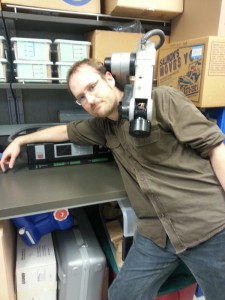Dear Colleagues,
It is my pleasure to introduce you to our newest lab member… actually it doesn’t have a name yet, but that’s the main reason for this post. This cute little guy/girl needs a name. I have been toying with TERMINATOR, HAL, iRob, and Rob(ot), but I’m sure you can do better. Could be male, female, or gender-neutral and whoever comes up with the best name gets a special treat.
Background
This is a high-end Scorbot, or at least it was high-end in the 90s but hasn’t been used in the last 7 years. I think it was a teaching robot but we’re going to see if we can get it to do some real work. It was donated by Mike Van der Loos from the Dept. of Mechanical Engineering, who provided this link:
http://www.theoldrobots.com/scorbot.html
#ROBOT_NAME# is currently camping out in the corner of the lab until I can find a suitable spot. I was thinking of the table in BioSci once the field harvest and drying season is over. Please let me know if you have any better ideas.


Sunflowers and robots are my most favourite things! Now they are together! 😀
This is neat!
I’m dying to know how customizable it is, mainly for improving safety. I would guess that it will be lifting eppendorf tubes or 96-well plates, weighing at most a few grams. The robot arm (by default) can lift a kilogram. If you can turn down the power so that the most it can lift is, say, 5 grams, and rotates with about the same force, it’ll be unable to hurt you as much (ie: shear forces where the joints rotate). That said, a body in motion tends to stay in motion, so if it’s already moving quickly, it’ll feel like a thrown object with that mass and speed, so don’t get hit by it, or don’t make it move quickly. 🙂
But in the end, you’ll probably want this to be in a laminar flow hood, biological safety cabinet, or big plexiglass box, just to keep your samples sterile. That should keep it away from body parts that you treasure, I bet!
And one more thing: robots need feedback! More precisely (pun intended), a robot without some sort of sensor can’t tell if the thing it’s going to pick up is in the right place. If the object has been moved slightly off-center, the gripper will either miss it or crash into it. One alternative is to make a plexiglass plate with holes cut out for 96-well plates, petri dishes, eppendorf tubes, and anything else you’ll want to use, and make sure that the plate never moves out of alignment relative to the robot. Another is to strap a webcam to the gripper, and have it look at what it’s doing, the Open CV (Computer Vision) library can help: http://sourceforge.net/projects/opencvlibrary/ . Maybe get a laser pointer on there too, so you can use the webcam to see how far away things are?
Looks like fun! 🙂
Neptr?
I like the name ULTIMATE DESTROYER, or alternatively, CHICKEN. 🙂